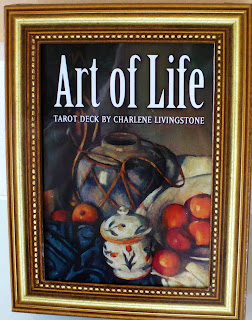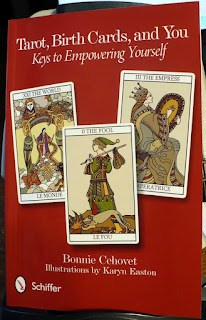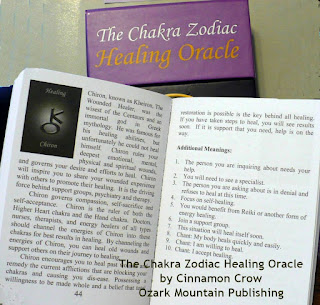R E V I E W
Tarot, Birth Cards, and You:
Keys to Empowering Yourself
by Bonnie Cehovet
Illustrations by Karyn Easton
Paperback: 192 pages
Schiffer Publishing, Ltd. (September 16, 2011)
ISBN-10: 0764339028
ISBN-13: 978-0764339028
THE PUBLISHER'S PRODUCT SUMMARY
"Use archetypes of Tarot's Major Arcana, combining energy with affirmations and journeying to help you define the path you walk in this lifetime and to reach your full potential. The guidebook employs a Birth Card system that forms a frame of reference for opportunities and challenges you will face during your life span. The tool of affirmations has been interfaced with the energy of an individual's Birth Cards to form a powerful avenue for personal transformation. Using the archetypal imagery of the Tarot, affirmations allow individuals to become co-creators in their own lives, to define what they want to manifest, and to then successfully manifest it. Combined with images from the stunning Tarot Lovers' Tarot, this is the ultimate tool for understanding yourself, your loved ones, coworkers, and friends. For all reader levels."
PREFACE (from the author)
"My hope is that with this book, readers will find the tools that will help them to better understand themselves, define their path for this lifetime, find their authentic voice, connect with that which they consider to be the Divine in their life, and move forward on their spiritual journey. The tools that I have chosen to work with are those of the Tarot Major Arcana, Affirmations, and Journeying. Together, they will help the reader define their path for this lifetime, and reach their full potential."
BASIC INFORMATION / APPEARANCE, SIZE, QUALITY / ART
Author Bonnie Cehovet has read the Tarot professionally for over fifteen years. She also writes reviews, interviews, and articles, and is a popular Tarot radio personality. To visit her web site, click
HERE:
Illustrator Karyn Easton is proprietor of paranormality.com and a professional designer/illustrator living and working in the UK. You can read an interview with her
HERE.
The book
Tarot, Birth Cards, and You is a standard trade paperback measuring 6 by 9 inches and containing 192 pages. The type is set in an easy-to read font, broken up with abundant white space, subheads in a decorative font, lists, bullet points, and black-and-white illustrations.
DETAILS / COMMENTS
The Preface contains the message quoted above, plus sections that describe and define The Tarot, Affirmations, and Journeying. Cehovet explains that the system used in this book was developed by Ruth Ann and Wald Amberstone of the
Tarot School. After providing the possible ways that our Birth Cards function in our lives according to the Amberstones, Cehovet amends that list of possibilities to include: (1) they are functioning well, (2) they are functioning poorly, (3) they are blocked, and (4) they are latent.
Following the Preface, we are introduced to a two-page section called
Calculating Your Birth Cards. The formula is explained clearly and concisely: "The numbers for the birth month, day, and year are added together, resulting in a two- or three-digit number." Cehovet goes on to explain how to proceed depending on whether the resulting number is a two-digit number or a three-digit number. Cehovet does not use The Fool card. She notes: "I like to think of the Fool as the one who is taking the journey, and is therefore set apart from the other cards."
For each pair of cards (or in one case, set of three cards), we are given black-and-white illustrations of the cards from the Tarot Lovers' Tarot, Astrological Associations, Keywords, and a Theme. We are then shown how individuals with those birth cards can empower themselves. Next, in each chapter, Cehovet offers details about each card and questions the card might prompt us to ask ourselves. This is followed by
Affirmations for the relevant cards, and separate
Journeying "directions" to be used with each card. Cehovet advises either taping the directions or having someone read them to you.
We are encouraged to begin our each Journey by "calling in the seven directions" (more about this later).
Next each chapter has a
Summary, followed by how individuals can "walk the lifetime" represented by their birth cards. This includes Gifts, Abilities, and Challenges for each card, along with how we can work with those gifts, abilities, and challenges.
After all of the birth card combinations have been explored, Cehovet provides a
PostScript in which she lists questions we might ask about our life, belief system, and so forth. She talks about self-confidence, success, choices, adjustments, fears, and dreams.
We are then given a
Bibliography and
Quick Tarot Birth Card Reference with illustrations of the cards in color.
As I discovered in Mary Greer's book
Who Are You in the Tarot (reviewed
HERE),
I am one of those special people who have three birth cards instead of two. My birth data adds up to 19, The Sun; the first reduced number, 10, gives me the Wheel of Fortune; the second reduced number, 1, gives me The Magician. In Greer's system, this places me in the Constellation of The Magician (Consciousness; Outer Sense of Self; Persona).
In the system used by Cehovet, the Sun/Wheel of Fortune/Magician triumvirate carries the
Theme of "Dealing with the concept of time in all its forms, and the change that comes with it." I love that!
Very briefly, The Sun asks me to open my heart to enlightenment, flow with life, enjoy my abundance, and honor it. In Cehovet's words, The Wheel of Fortune "screams 'Pay attention!' Stay in the present, be aware of what is going on around you, who is involved, and what their agenda might be. (Or what your own agenda might be!)." Finally, The Magician asks me to acknowledge and make use of my personal power and how I connect with spirit.
Together, these three birth cards "work together to help the individual understand the aspect of time (past/present/future) in their life." Astrologically, my birth cards link me to the Sun, Jupiter, and Mercury. How appropriate that Jupiter rules my Sun sign and Mercury rules my Rising sign!
Calling In the Seven Directions
To prepare for Journeying, we are encouraged to use a "summoning script" provided by the author. This consists of calling upon the Guardians of the four directions, along with the Sky, the Earth, and our Inner Self. For each summons, we also include a totem animal and specific gifts that will help us on our Journey. For example: "Guardians of the East, and Brother Owl, please join us on our journey. We ask for your help with vision and clarity."
I was fascinated by this, so I asked Bonnie Cehovet about its source. She tells me that it is based on U.S. Native American lore. Of course there were (are) hundreds of different Native American tribes (565 tribes as of October 2010, according to the U.S. government). Each tribe has its own legends and lore. The interpretations of animals and directions can vary within each tribe. All of them attribute certain characteristics or powers to animals, and most of them also use the four directions in their spiritual practices.
For example, according to the
Four Directions web site maintained by a branch of the Northern Cherokee Nation, one set of associations pairs the Eagle with East, the Rabbit with South, the Bear with West, and the Buck with North.
BOTTOM LINE
Tarot, Birth Cards, and You has a very personal feel to it, with a separate chapter devoted to each combination of cards. As you learn to walk the Lifetime represented by your Birth Cards, you will have a wise and supportive companion in Bonnie Cehovet. Her hope that this book will "help the reader define their path for this lifetime, and reach their full potential" is certain to be fulfilled.
Of particular value are the lists of questions we can pose to each card. By reading and answering these questions, we gain tremendous insights into the cards and how we can relate to them at a personal, practical level.
In addition to learning about my self from this book, I look forward to using it with clients. Cehovet recommends pulling the Seeker's Birth Cards from a deck that is not being used and placing them above the reading. I agree with her statement: "This gives both the reader and the Seeker a visual image of the energetic theme for this lifetime. The Seeker conducts his/her life between these parameters."
While astrological associations are included for the cards, Astrology is not a primary focus. Readers who know nothing of Astrology will still reap the full benefit of the material in this book.
In
accordance with the FTC Guidelines for blogging and endorsements, I hereby
disclose that this product was provided by the publisher for free. Other than
the occasional review copy, I receive no monetary or in-kind compensation for
my reviews. The substance of my reviews
is not influenced by whether I do or do not receive a review copy.







































